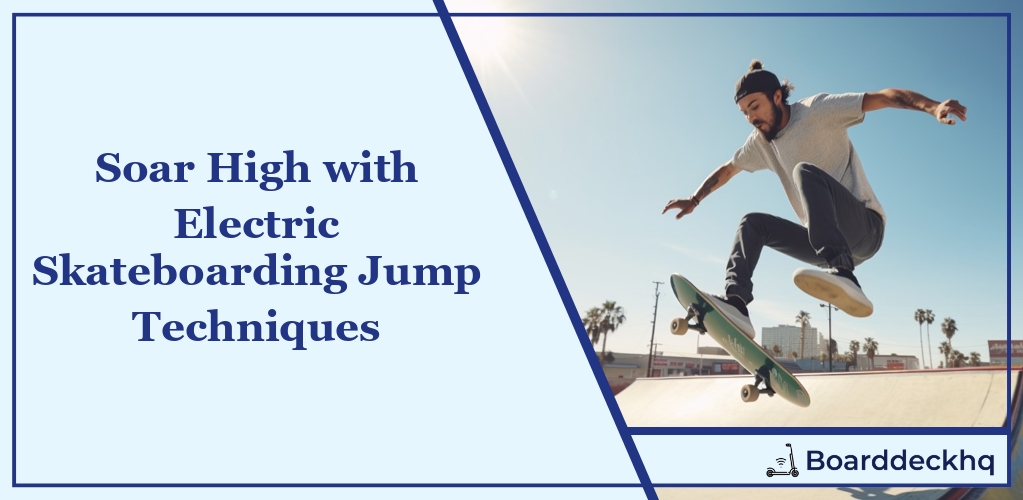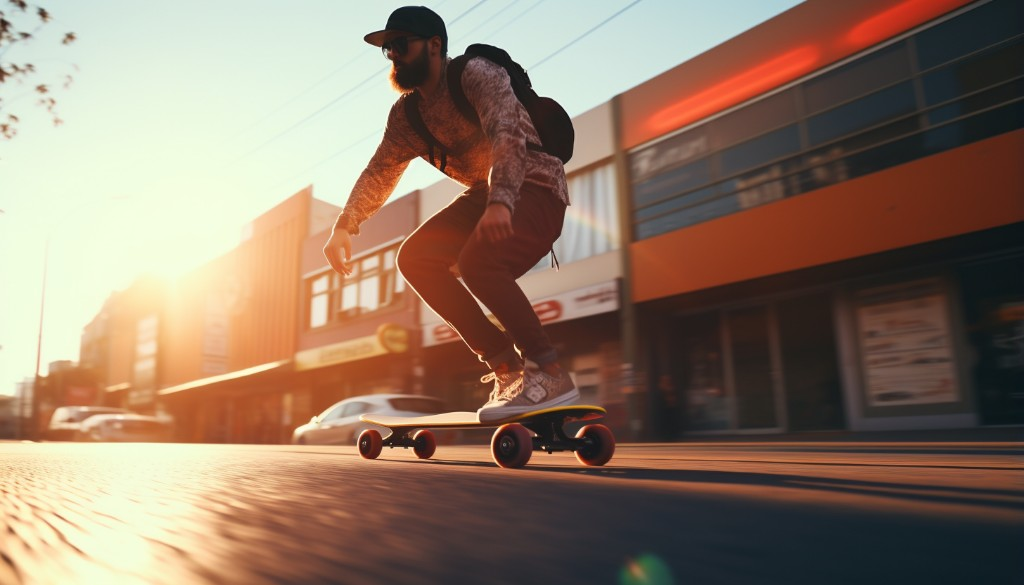Unleash your inner daredevil with electric skateboarding jump techniques that are sure to thrill and impress. Whether you’re a novice looking to understand the basics, or a seasoned pro ready to tackle advanced stunts, this comprehensive guide will serve as your mentor. Get ready to master the art of the widely acclaimed Ollie, conquer the Kickflip’s challenge, and execute the 360 Flip and Heelflip with unwavering confidence. Not forgetting techniques for executing tricky Pop Shove-its, Hardflips, and mastering the Manual with its partner in crime – the Kickturn. You’ll even learn how to deftly navigate street obstacles, and perform ambitious techniques such as dropping in, grinding, and banking. We’ll also offer insights into how skateboard components can impact your jumps and discuss crucial safety measures to keep in mind as you embark on this thrilling journey.
What we’ll cover:
- Electric Skateboarding Basics
- Footedness in Skateboarding
- Mastering the Ollie
- Kickflip Techniques
- Advanced Jumps: 360 Flip and Heelflip
- Trick Jumps: Pop Shove-its and Hardflips
- Manual and Kickturn Techniques
- Essential Stunts: Carving, Pumping, Sliding
- Ambitious Techniques: Dropping in, Grinding, Banking
- Skateboard Components and Jump Techniques
- Navigating Street Obstacles
So let’s jump right in and show you why electric skateboarding isn’t just a sport – it’s an art!
Understanding Electric Skateboarding Basics
Electric skateboarding is a thrilling venture that combines the adrenaline-filled experience of traditional skateboarding with the ease and convenience of motorization. Unlike its conventional counterpart, an electric skateboard operates with a battery-operated motor which allows riders to move without the need to push off the ground. This evolution provides a whole new level of mobility and freedom.
There are various types of electric skateboards available in the market today. For starters, we have the all-rounder boards. These are versatile and great for commuting, cruising, or even tackling mild off-road terrain. Then there are the off-road boards which can handle rough terrain, including dirt and gravel paths, with ease, thanks to their powerful motors and rugged wheels.

Street boards, on the other hand, are built for speed, agility, and performance. They’re ideal for those who love to ride an electric skateboard at high speeds or carve up the streets. Last, but certainly not least, are cruiser boards. These are perfect for leisurely rides, as they are designed for comfort and stability over long distances. When one learns to ride an electric skateboard, they dive into a world of new possibilities.
Deciphering Footedness in Electric Skateboarding
Every rider has a dominant foot which leads when riding an electric skateboard. This concept is known as ‘footedness’. It’s vital to know your footedness as it influences balance, control, and jumping techniques.
There are two main types of footedness: regular foot and goofy stance. Regular foot means your left foot leads (is on the front of the board) and your right foot is at the back. Conversely, a goofy stance refers to leading with your right foot and having your left foot at the back.
Understanding your preferred footedness is essential as it affects your balance and control of the skateboard. Foot placement is also crucial when steering and performing tricks. Your front foot typically balances and steers the board, while your back foot manages propulsion and tricks.
When learning how to ride an electric skateboard, it’s vital to experiment with both stances to determine what feels most natural. Only then should you venture into the realm of skateboarding tricks for beginners.
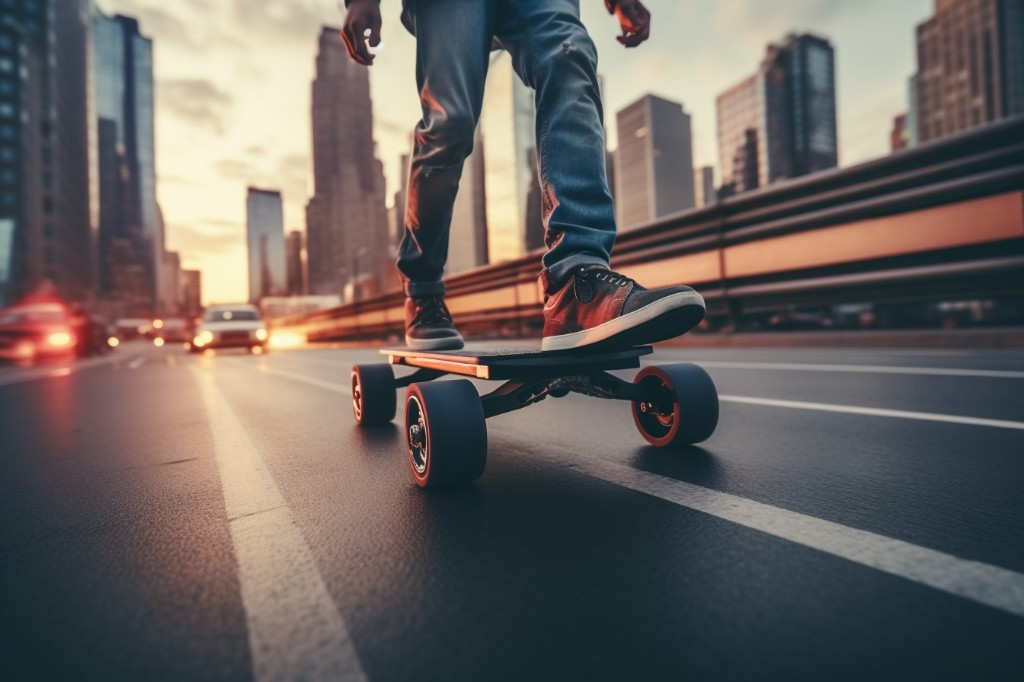
Mastering the Art of the Ollie in Electric Skateboarding
The Ollie is a fundamental trick in skateboarding that involves lifting both the rider and the skateboard off the ground using only the rider’s feet. Performing this maneuver on an electric skateboard can be quite challenging, but with practice and persistence, it can be done.
Here’s a simple guide to perform an Ollie:
- Position your back foot on the tail of the electric skateboard and place your front foot across the board (about two-thirds up).
- Bend your knees and crouch down.
- In one fluid motion, pop down hard on the tail of the skateboard with your back foot while simultaneously dragging the side of your front foot up towards the nose.
- As the board rises, suck up your knees to allow the board to lift higher.
- Once in mid-air, level out the skateboard using your front foot.
- Land smoothly with both feet on the bolts and bend your knees to absorb impact.
Common mistakes beginners make when learning to Ollie include not popping hard enough, failing to drag up their front foot properly or not leveling out the skateboard in mid-air.
As riders grow more comfortable with their electric skateboard and improve their Ollie technique, they’ll be able to use this foundational move in a plethora of other jumping techniques and tricks.
Tackling the Kickflip on an Electric Skateboard
The Kickflip is a signature trick in skateboarding, and it’s every bit as thrilling on an electric skateboard. Let’s delve into the steps involved in pulling off this move.
The first step is getting in the right stance. Position your back foot on the tail of the electric skateboard, just like you would for an Ollie. Your front foot needs to be angled diagonally across the board, with your toes in line with the front bolts. This is your starting position.
Now comes the actual Kickflip. Start by pushing down with your back foot to pop the board into the air. At the same time, drag the edge of your front foot up the board to make it flip. The dragging motion of your front foot is what makes a Kickflip different from an Ollie.
Common mistakes to avoid include flipping the board too much or too little. This is where practice comes in. It’s all about finding that sweet spot where you flip just enough to land back on the board.
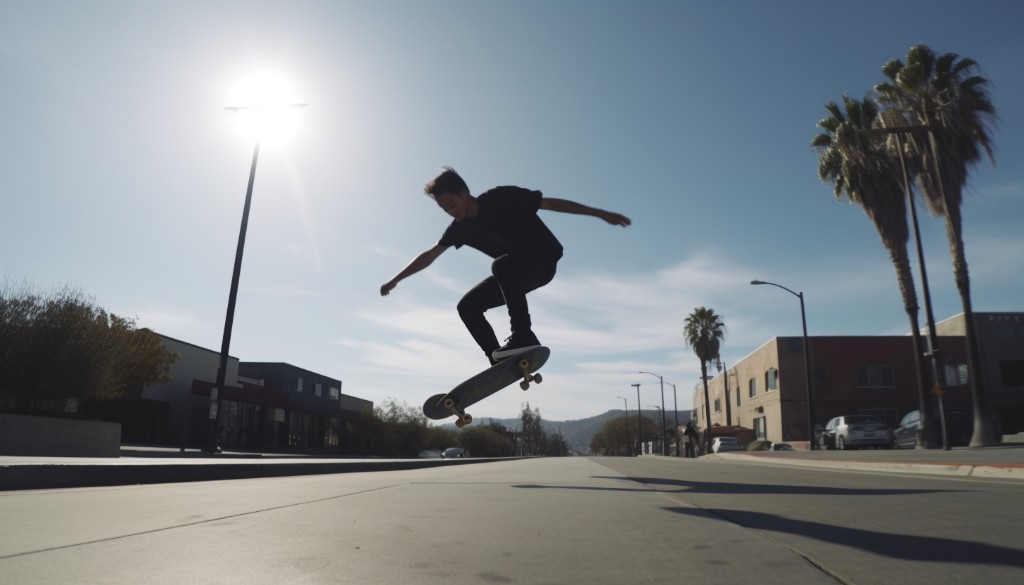
Advanced Jump Techniques: The 360 Flip and Heelflip
Once you’ve mastered the Kickflip, it’s time to ride an electric skateboard into more advanced trick territory. Two standout moves in this domain are the 360 Flip and the Heelflip.
The 360 Flip is a combination of a Kickflip and a 360-degree turn of the board (also known as a 360 Shove-it). Here’s how to do it:
- Set up like you would for a Kickflip, but position your back foot on the very edge of the tail.
- Pop the tail and scoop it around with your back foot while simultaneously dragging your front foot up and outwards.
- Let the board spin under you, and catch it with your back foot once it completes a full flip and 360-degree turn.
Next up is the Heelflip, which is similar to a Kickflip but involves flipping the board using your heel instead:
- Position your front foot with the toes hanging off the board.
- Pop and drag like you would for a Kickflip, but use your heel to make the board flip in the opposite direction.
- Catch and land..
Remember that these tricks require a higher skill level, so it’s crucial to practice and perfect them consistently.
Electric Skateboarding Trick Jumps: Pop Shove-its and Hardflips
Moving on to some stellar trick jumps in electric skateboarding – Pop Shove-it and Hardflip. Let’s take a look at what these involve, along with the steps to execute them effectively.
A Pop Shove-it is essentially a 180-degree spin of the skateboard while you remain in place. Here’s how to do it:
- Set up with your back foot on the tail and front foot across the middle of the board.
- Give a powerful push downwards on the tail.
- Use your back foot to scoop the tail around, which will make the board spin under you.
- Catch and land without turning your body.
The Hardflip, on the other hand, is a combination of a Kickflip and a frontside Pop Shove-it:
- Start like you would for a Kickflip, but angle your front foot more across the board.
- Pop and drag just like in a Kickflip, but give an extra scoop with your back foot to make the board also spin frontside.
- Catch it mid-flip with your back foot and land smoothly.
The world of electric skateboarding tricks is wide and exciting, offering endless opportunities for fun and challenge. With commitment and practice, you can master these tricks and impress anyone watching!

Techniques to Perfect the Manual and Kickturn
Trying to master the Manual and Kickturn using an electric skateboard can be both a thrilling and challenging task. These maneuvers require balance, precision, and determination. But, with the right techniques, you can perfect these tricks and make your skating sessions even more enjoyable.
The Manual on Electric Skateboard
The Manual is a classic skateboard trick that involves balancing on the rear wheels whilst keeping the front wheels off the ground. It’s like doing a wheelie on a bike. To execute a perfect Manual on an electric skateboard, here are some steps to follow:
- Place your back foot on the tail of your skateboard and your front foot slightly behind the front bolts.
- Lean back a little bit and lift your front foot off the ground. Be careful not to lean too far back or else you will lose balance.
- Try to maintain balance for as long as you can while keeping your front foot off the ground.
The Kickturn Trick
The Kickturn, on the other hand, is a maneuver where you pivot on the back wheels while lifting the front wheels off the ground to change direction quickly. Here’s how to perform a Kickturn:
- Position your front foot across the skateboard and place your back foot on the tail as if performing a Manual.
- Apply pressure to the tail and lift your front foot.
- Rotate your shoulders in the direction you want to turn. The skateboard will follow your body’s movement.
- Put your front foot down and you have completed a Kickturn.

Essential Jump Stunts: Carving, Pumping, and Sliding
Electric skateboarding provides opportunities for performing exciting jump stunts that elevate your riding experience. Three essential jump stunts to master are Carving, Pumping, and Sliding.
Carving on Electric Skateboard
Carving is a technique where you make S-shaped patterns while riding your electric skateboard, much like in surfing or snowboarding. Here’s how to carve:
- Start by riding straight.
- Shift your weight to one side to start turning.
- Shift weight to the other side to steer in the other direction.
- Repeat these steps for a carving motion.
Pumping Technique
Pumping is a technique where you generate momentum without pushing off the ground, making it perfect for electric skateboarding. Here’s how to pump:
- Start by riding straight.
- Shift your weight from one side of the board to the other in a rhythmic motion.
- As you shift weight towards one side, lean into it for more force.
- Continue this motion to generate speed without having to push off the ground.
Sliding Trick
Sliding is another fun trick in electric skateboarding where you force the board to slide sideways along its wheels rather than rolling. To perform a slide:
- Ride at a moderate speed.
- Shift your weight towards the tail of the board.
- Turn your shoulders in the direction you want to slide.
- Push out with your back foot to force the board into a slide.
Ambitious Techniques: Dropping in, Grinding, and Banking
As you delve deeper into the world of electric skateboarding, you’ll eventually come across advanced techniques that are not just about speed and balance, but also about style and skill. Three of these techniques – Dropping in, Grinding, and Banking – stand out due to their complexity and the adrenaline rush they offer.
Dropping In
Dropping in is a technique that initiates a ride from the top of a ramp. It’s one of the most thrilling methods used in electric skateboarding. Let’s break down the steps to execute this maneuver safely:
- Start by placing your skateboard’s tail on the coping (the lip of the ramp), with the nose pointing down into the ramp.
- Shift your weight forward over the skateboard’s front trucks, pushing down until the front wheels touch the ramp.
- Fully shift your weight onto your front foot and keep your body centered over the skateboard as you descend.
Grinding
Grinding involves sliding along an object, such as a ledge or rail, using your skateboard’s trucks or deck. It requires precision and balance:
- Approach the object with moderate speed.
- Ollie (a jump where the board leaves the ground) onto the object, positioning your trucks for contact.
- Maintain your balance and slide along the object.
- Exit by either letting gravity pull you away or by executing an Ollie to disengage from the object.
Banking
Banking involves making turns on inclined surfaces without losing momentum or control. It’s a crucial skill for maintaining speed and flow while skateboarding. Here’s how to bank:
- Approach the banked surface at an angle with sufficient speed.
- Shift your weight towards your heels or toes, depending on the direction of the turn.
- Lean your body into the turn and keep your eyes focused on your exit point.
- Exit by shifting your weight back to neutral and steering away from the bank.
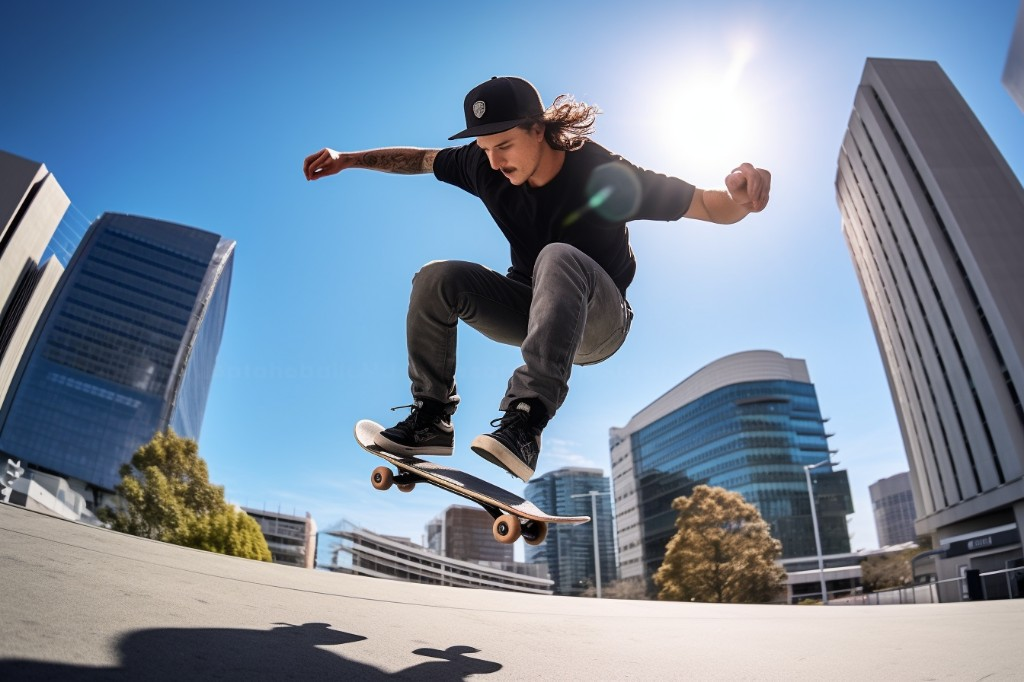 Understanding the Impact of Skateboard Components on Jump Techniques
Understanding the Impact of Skateboard Components on Jump Techniques
In electric skateboarding, understanding how different components affect jump techniques is crucial for optimizing performance and ensuring safety.
The Influence of the Deck
The deck is where you stand on an electric skateboard, so its form can significantly affect the way you execute jumps. A lighter deck can make it easier to lift off the ground, while a wider deck provides more space for foot movement during complex maneuvers.
Role of Trucks in Jumps
Trucks connect the wheels to the deck and directly impact how an electric skateboard moves. Tightening or loosening your trucks can change your board’s responsiveness, affecting how sharply you can turn when executing a jump.
How Wheels Affect Jumps
The wheels also play a pivotal role in jump techniques in electric skateboarding. Bigger wheels can help you gain more speed for higher jumps, while softer wheels provide better grip for landing.
In conclusion, mastering advanced techniques like Dropping in, Grinding, and Banking, requires a deep understanding of not just ones riding skills but also how different components of an electric skateboard interact with each other during these maneuvers.
Overcoming Street Obstacles: Potholes and Speed Bumps
Street skateboarding on an electric skateboard often involves navigating through various obstacles like potholes and speed bumps. It’s essential to learn techniques that help overcome these obstacles while performing jumps.
Navigating Potholes
Potholes can be a menace for any skater. Here’s how to tackle them:
- Always be aware of your surroundings and spot potholes from afar.
- Once spotted, shift your weight towards the back of the board.
- Lift up the front of your board just before reaching the pothole.
- Land with both feet on the board after clearing the pothole.
Handling Speed Bumps
Speed bumps could affect your momentum but they can be managed with these steps:
- Spot the speed bump from afar to prepare.
- Approach it at an angle rather than straight on.
- Bend your knees and prepare for impact.
- Absorb the impact by flexing your knees upon landing.
Mastering these strategies will help you overcome common street obstacles and continue enjoying your electric skateboarding experience without interruptions!
Closing Thoughts
The world of electric skateboarding opens up a thrilling landscape of tricks, flips, and jumps. Mastering the basics sets a solid foundation, beginning with understanding your footedness to help you maintain balance while riding. As you progress, tricks like the Ollie, Kickflip, and advanced techniques like the 360 Flip and Heelflip become key in your repertoire. Jump stunts like Carving, Pumping, and Sliding also add to your skill set. Even street obstacles like potholes and speed bumps can be tackled with practice. However, as exciting as these tricks are, safety remains paramount in electric skateboarding. The use of safety gear like helmets, knee pads, and elbow pads cannot be stressed enough – they can significantly reduce risks of injuries. Remember: the key to mastering any trick is practice. So, get out there and showcase your skills!
Frequently Asked Questions
What are some basic jumping techniques that I can start with as a beginner?
Starting with basic jumping techniques is always recommended. Two such beginner-friendly techniques are the Ollie and the Kickflip. The Ollie is where you pop your board into the air without using your hands, while the Kickflip involves flipping the board in mid-air under your feet.
How can I improve my balance while performing jumps on my electric skateboard?
Improving balance in electric skateboarding jumps mainly involves understanding and mastering your footedness. This refers to which foot you naturally place in front on the board. Regular footedness means left foot in front, while goofy footedness means right foot in front. Practicing with this foot forward can greatly improve your balance.
What is the role of ‘footedness’ in electric skateboarding jumps?
Footedness plays a vital role in maintaining balance during electric skateboarding jumps. It refers to the leading foot on the skateboard – if you naturally ride with the left foot forward, you are considered ‘regular’, while a right foot forward is known as ‘goofy’. Knowing your footedness helps you understand your balance point and execute jumps better.
What safety measures should I follow while attempting jump tricks?
When attempting jump tricks, wearing safety gear is critical. This includes helmets, knee pads, and elbow pads, which all play significant roles in preventing injuries. Also, understanding electric skateboard components and how they can affect jump techniques will further enhance your safety.
How can street obstacles like potholes and speed bumps affect my performance while performing jumps?
Street obstacles like potholes and speed bumps can significantly affect your performance during jumps. They can disrupt balance, momentum, and even cause accidents if not navigated properly. However, with practice and experience, you can learn to tackle these obstacles seamlessly during your ride.
